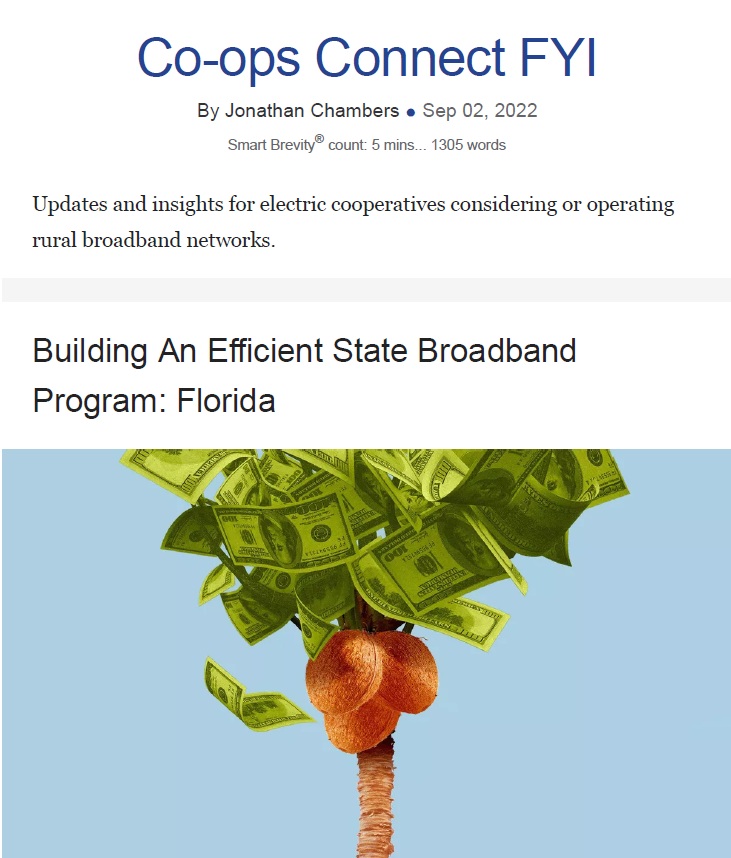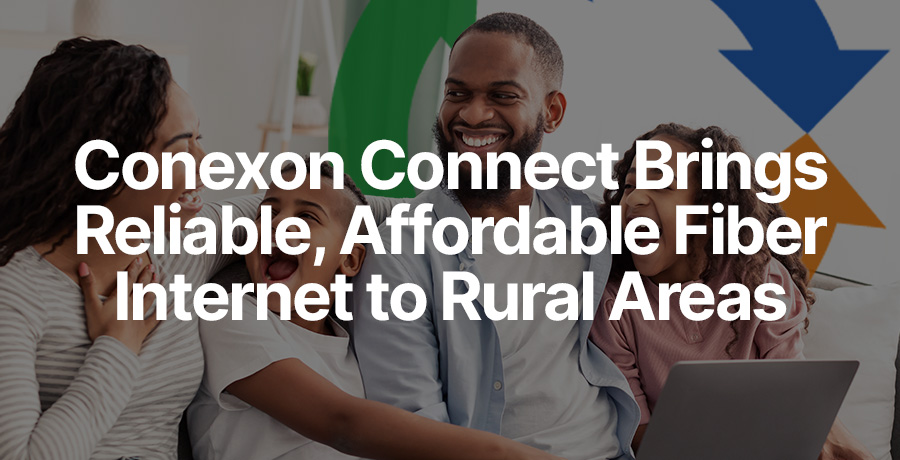Building An Efficient State Broadband Program: Florida
September 2, 2022
Over the past two weeks, the Florida Department of Economic Opportunity’s Office of Broadband hosted a series of regional broadband workshops to seek community input and public comment about available broadband funding.
Our perspective:
Conexon submitted the following public comment to the Office of Broadband in Florida, suggesting 10 steps to create that program.
- These steps are not exclusive to Florida. All states can and should follow the same approach.
Get started:
To close the digital divide, any state broadband program should address two key questions:
1. What level of internet access will exist in urban areas in a decade’s time?
2. What will be reasonably comparable to that service?
Planning Matters
Go deeper:
Today, Conexon Connect offers affordable multi-Gigabit symmetrical service in rural areas. At a minimum, a program should fund onlynetworks capable of multi-Gigabit symmetrical service today that are capable of keeping pace with the Internet’s evolution.
The objective of affordable multi-Gigabit symmetrical service everywhere is achievable by the state of Florida, provided the program is run with that objective in mind.
- It is critical that the current planning take into account the amount of funding that will be allocated to Florida through the BEAD program.
- We estimate nearly an additional $1.4 billion for rural broadband.
- If states do not apply for or use their full allocation, the funding will be allocated to other states.
- The bottom line: We think, at a minimum, the state’s planning should assume $1.5 billion for rural broadband.
What’s next:
We offer these 10 steps that could be taken by the state to achieve the objective of closing the digital divide everywhere in the state.
Preparation Matters
An efficient state broadband program starts with careful process planning.
1. Identify unserved, underserved, and partially served census blocks in the state. Challenges by incumbent ISPs to the broadband maps should require evidence, not mere assertion.
- Use either FCC maps prepared pursuant to the DATA Act, or NTIA maps, state maps, regional maps, or county maps.
- According to the most recent FCC data, nearly 150,000 l0cations are unserved (lacking access to 25/3 Mbps), and another 200,000 locations are underserved (lacking access to 100/20 Mbps). Most of the unserved census blocks were included in the Rural Digital Opportunity Fund program.
- The state should publish maps of eligible areas. Applicants for funding should be able to depend on the state’s maps.
- In other words, challenges to the state’s identification of eligible areas should require sufficient evidence to overcome a presumption that the areas are unserved or underserved.
- As of September 1, every ISP in the state has presented detailed data to the FCC concerning the locations of service, technology type, speed and other service characteristics.
- Why it matters: Any ISP wishing to challenge state or county eligibility maps should be required to make its FCC broadband data collection filing public with respect to any challenged areas.
2. Allocate funding by census block according to the Infrastructure Act (BEAD) formula or the projected cost to construct fiber networks.
- The Infrastructure Act will allocate funding to each state according to the percentage of unserved locations in a state as compared to the country.
- A state could take the same approach at a local level, allocating funding according to the percentage of unserved locations in a county as compared to the state.
- Alternatively, utilize a cost model such as the FCC’s Connect America Cost Model to determine the appropriate amount of funding by census block.
3. Set the required service for applicants at the level of service reasonably comparable to service in urban areas in the state.
- The divide is widening because programs do not follow the dictates of the Universal Service provisions of the 1996 Federal Telecommunications Act. Those provisions required the federal and state governments to ensure that rural areas had affordable access to service that is reasonably comparable to service available in urban areas.
- Today, ISPs including AT&T, Google Fiber, and Conexon Connect offer affordable multi-Gigabit symmetrical service.
- Why it matters: To fund lesser technologies in rural areas will perpetuate the digital divide and force future governors and legislatures to spend public money again in the very same places.
Applications Matter
How state broadband offices approach applications is key.
4. Accept applications from companies that can demonstrate the capacity to build and operate networks in the eligible census blocks.
- The most successful funding programs use measurable criteria that narrow the decision to a few key elements.
- Awards should automatically be made to any network that:
1) Can provide symmetrical multi-Gigabit speeds.
2) Will be owned by the community served.
3) Can be built within a year.
4) Can be built for the allocated funds.
- The overriding determination should focus on who is best suited to construct, operate, and maintain a network in the coming decades.
- Prioritize funding to applicants where the network will be owned by the community served by the network.
5. Vet applicants using objective criteria, including demonstrated capability to construct and operate the size and type of network and level of service proposed in the application.
- Vetting could include proof of design maps, access to materials and labor, and participation in related federal programs, such as the Affordable Connectivity Program.
- At a minimum, applicants should be able to demonstrate access to design, materials, construction labor, access to poles, conduit and right of way for the project within a year.
6. Approve applications for only a single year’s construction.
- Most state and federal broadband programs have been overwhelmed with funding requests.
- Structuring a program according to a yearly schedule forces applicants to apply only for what they can use in the coming year.
- This simplifies both application and oversight processes.
7. For census blocks covered by multiple applications, require funds be awarded to a community-owned network.
- If none of the projects are community-owned, then require applicants to submit a second, final application with a request for funding the overlapping census blocks.
- Then, award to the low-cost applicant.
Why it matters:
An annual process will result in a more orderly, systematic build-out and will be easier to administer and monitor by the small staff of state broadband offices.
- As compared to 10-year programs such as RDOF or CAF, programs with yearly schedules are more manageable and adjustable.
Verification Matters
To ensure program success, end with project verification.
8. Reimburse projects upon completion and demonstration that every location has access to the requisite level of service.
- It is far easier to audit completed construction than it is to administer an invoice reimbursement process.
9. In nine months, conduct the next round of funding applications.
- For applicants from the prior round, permit a follow-on application only if the applicant has substantially completed work from the prior round.
- The incentive for applicants should be to apply only for what they can complete.
Why it matters:
Funding won’t be tied up by companies who apply to block others from competing with them, as occurred in the RDOF auction.
10. After two rounds of funding, for any census block that has not received any applications, allow applicants to propose an amount of funding greater than the allocated amount. For census blocks with duplicative applications, award to the low-cost applicant.
- While not every geographic area of a state may receive an initial application, within two years it will be clearer which areas may need more than the initial allocation.
The Big Picture for Florida
Florida will receive a large enough allocation from the Infrastructure Act to build a fiber network to reach every rural home.
The bottom line:
This $1.5 billion opportunity to close the digital divide in Florida is not a once-in-a-generation or once-in-a-decade opportunity. It is a once opportunity.

